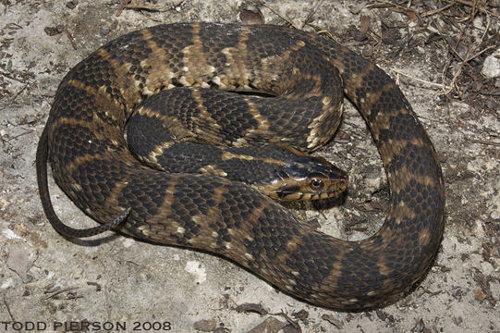Southern Watersnake
-
Scientific Name
Nerodia fasciata - Visit ITIS for full scientific classification.
-
Description
 Southern watersnake. © 2008 Todd Pierson
Southern watersnake. © 2008 Todd Pierson- Dark-colored, heavy-bodied snakes.
- Can be black, brown, tan, reddish, yellowish, or gray in color, with crossbands.
- Coloration varies between the three subspecies: Florida, Banded, and Broad-banded.
- Bellies are marked with square or triangular shaped markings.
- Possible for individuals to get up to 5 feet long.
- Not a venomous snake, but they can aggressively bite and discharge a musky, foul-smelling substance when threatened.
-
Habitat
- Found in a wide variety of freshwater habitats including: ponds, lakes, ditches, streams, rivers, etc.
- Also found in some brackish water habitats including swamps and marshes.
- Usually found basking in the sun, or hiding in burrows or under vegetation.
-
Invasion Pathways and Distribution
- Watersnakes make poor pets, but are still found in the pet trade.
- Therefore, the most likely pathway of introduction to non-native areas is release from pet owners.
- Native to Florida and the eastern U.S.
- Now found in some areas of California.
- See USGS for a map of current U.S. distribution.
-
Life History
- Mothers retain eggs internally and give birth to live young in the summer and fall.
- Juveniles are paler and have stronger patterns than the adults.
- Other details including life span, litter size, and mating behaviors may differ between subspecies.
-
Impacts
- Predators that feed on a variety of different animals including fish, amphibians, worms, turtles, birds, etc.
- Individuals can travel across land for over a mile to find more food and new habitats.
- Their ability to disperse, in combination with their tolerance for brackish water, as well as their varied diet, gives them the potential to threaten native species including California's garter snakes.
-
References and Useful Links
For references by category and links to other useful AIS sites see our Learn More page.

